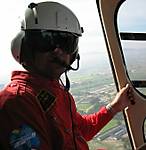The Bölkow Bo-102 Helitrainer was an unusual ground-based helicopter training aid that was developed and built by Bölkow of Germany in the late 1950s. It embodied all essential elements of a conventional helicopter, but was mounted on an articulated gantry to allow a student controlled experience of helicopter systems. Designed to be mounted on a swivelling captive rig the Bölkow Bo-102 Helitrainer allowed trainee pilots to practice procedures such as engine starting, rotor engagement and manipulation of the flight controls. Many of the Bo 102's components, including the single bladed fiberglass main rotor were used in the company's next design, the Bölkow Bo-103.



Rolled out in 1957, this Helitrainer was powered by a Hirth 3-cylinder / 2-stroke 40hp ILO L3X375 piston engine rated at 30 kW, driving a simple 21 foot one-bladed fiberglass rotor with a counterweight. In all 18 of these Helitrainers were built operating throughout Europe, training military helicopter pilots. Although unable to fly, they were ideal for the teaching of hovering techniques and were replaced by dual trainer helicopters.



The Bölkow Bo-102 Helitrainer offered a variety of advantages for a safe helicopter training and was developed in land and water based versions, both of which were semi-captive. The first training section was conducted on this model mounted on a boogie. It facilitated the training of starting, tuning the rotary speed, taking off, hovering, turning, and landing. Simple exercising device for beginners’ training. Safety risk minimized by captivation, yet limited flight maneuvers possible. This feature allowed the helicopter to rise to a height of 2 m (6 ft), turn around a vertical axis and dip at up to 6° but prevented it from flying outside these limits.
Looks like a kiddie heliride, a toy for big boys huh? :rolleyes:

Unfortunately, the Bölkow Bo-102 Helitrainer did not gain general approval because of its costs being nearly as high as a small helicopter. Luckily, very few of them, are still surviving as public display exhibit at the Hubschraubermuseum Bückeburg Germany, the helicopter museum Weston and in Rota museum Spain. Parts of BO-102B were found at a freight forwarding company in Vlotho and donated to the helicopter museum in Buckeburg. The workshop team, managed to restore few of these experimental helicopter training devices.


Technical data & general characteristics
- Type designation: Bo-102B Helitrainer
- Usage: Single seated captive helicopter trainer for basic helicopter training
- Year of construction: 1958
- Manufacturer: Bölkow Entwicklungen KG
- Country: Germany
- Length: 5.68 m
- Main rotor area: 34.8 m² (374 sq feet)
- Main rotor diameter: 6.58 m (21 ft 8 in)
- Powerplant: 1 x Hirth 3-cylinder / 2-stroke 40hp ILO L3X375 piston engine rated at 30 kW
- Power: 40 shp
- Gross weight: 770 kg (1697 lb)
- Take off weight without a platform: 325kg
- Crew: 1 student pilot & 1 trainer (on additional seat)
- Speed: Handcuffed on the ground
- Range: Stationary base coach

































































































































































